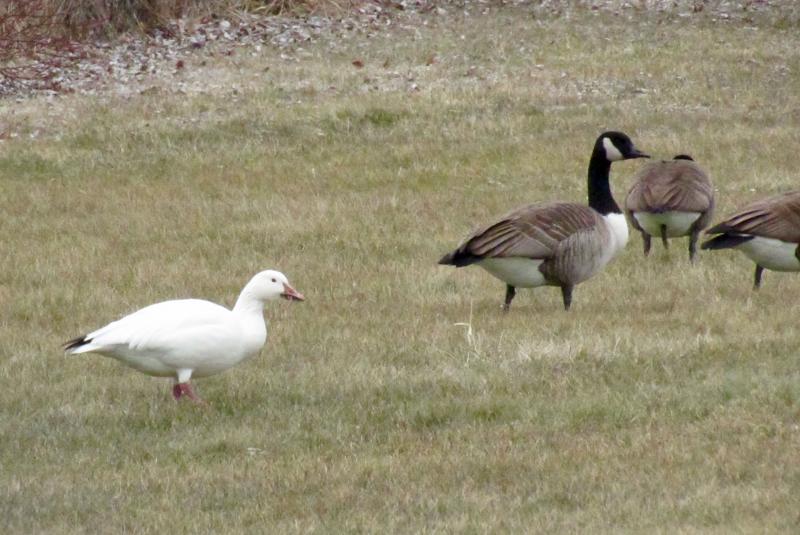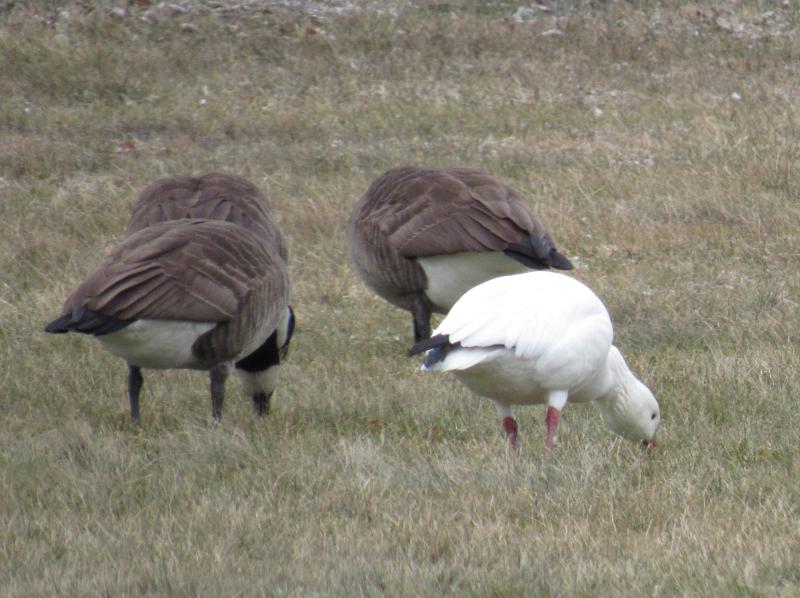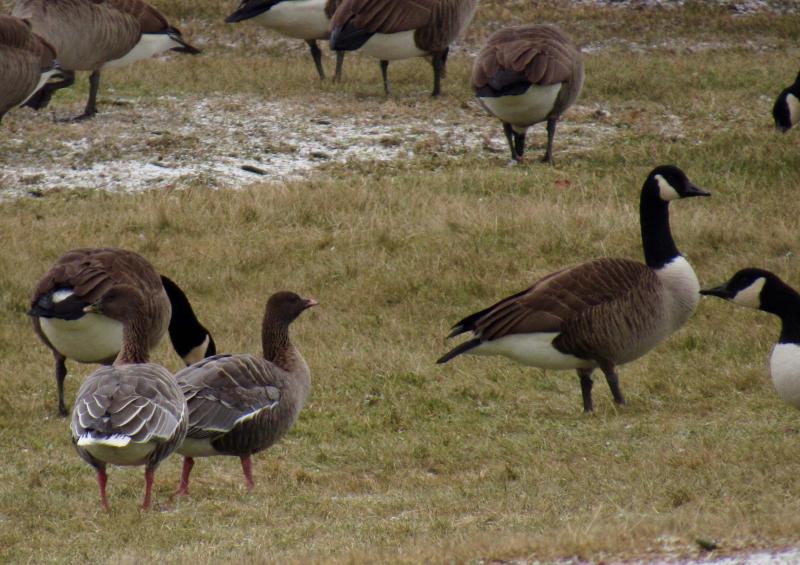Kristen Lindquist: Meditations on the Snow Goose
 The Snow Goose (left) found in Rockland in December 2016 is hanging out with a large flock of Canada Geese. (Photo courtesy Kristen Lindquist)
The Snow Goose (left) found in Rockland in December 2016 is hanging out with a large flock of Canada Geese. (Photo courtesy Kristen Lindquist)
 SnowGoosegrazing. (Photo courtesy Kristen Lindquist)
SnowGoosegrazing. (Photo courtesy Kristen Lindquist)
 The Rockland Snow Goose (left) with Canada Goose (center) and rare Pink-footed Goose. (Photo courtesy Kristen Lindquist)
The Rockland Snow Goose (left) with Canada Goose (center) and rare Pink-footed Goose. (Photo courtesy Kristen Lindquist)
 Two rare Pink-footed Geese (left foreground) recently found amid a flock of Canada Geese in Rockland.
Two rare Pink-footed Geese (left foreground) recently found amid a flock of Canada Geese in Rockland.
 Kristen Lindquist
Kristen Lindquist
 The Snow Goose (left) found in Rockland in December 2016 is hanging out with a large flock of Canada Geese. (Photo courtesy Kristen Lindquist)
The Snow Goose (left) found in Rockland in December 2016 is hanging out with a large flock of Canada Geese. (Photo courtesy Kristen Lindquist)
 SnowGoosegrazing. (Photo courtesy Kristen Lindquist)
SnowGoosegrazing. (Photo courtesy Kristen Lindquist)
 The Rockland Snow Goose (left) with Canada Goose (center) and rare Pink-footed Goose. (Photo courtesy Kristen Lindquist)
The Rockland Snow Goose (left) with Canada Goose (center) and rare Pink-footed Goose. (Photo courtesy Kristen Lindquist)
 Two rare Pink-footed Geese (left foreground) recently found amid a flock of Canada Geese in Rockland.
Two rare Pink-footed Geese (left foreground) recently found amid a flock of Canada Geese in Rockland.
 Kristen Lindquist
Kristen Lindquist
While the Snow Goose is one of the most abundant species of waterfowl, with a burgeoning world population estimated at more than five million, it's an uncommon visitor in Maine. Named for its white color, not its preferred weather, the goose is even more unusual here when snow is on the ground. The bird prefers to winter well south of us along the mid-Atlantic and southern coasts and up into the fallow farm fields of the central Great Plains. So local birder Don Reimer's recent discovery of a Snow Goose amid a grazing flock of Canada Geese in Rockland was noteworthy.
Even more noteworthy was Don's additional discovery a few days later, in that same flock, of two Pink-footed Geese. There are fewer than ten accepted records in Maine of the Pink-footed Goose, which breeds in northeastern Greenland. So the two "Pinks" have been the big draw, attracting crowds of birders from around the state and beyond.
But the Snow Goose, a large and striking white bird with black primaries, is arguably the more charismatic. It stands out as something special in the way that white creatures—from Moby Dick to the magical Snowy Owl—often do.
A color variation or morph of the Snow Goose, called the "blue goose," retains the white head and neck but sports a dark gray body. Interestingly, here in coastal Maine most of the Snow Geese I've observed previously have been "blue geese," and always a single bird or two tucked in with a bunch of Canada Geese. But Snow Geese don't fly solo. They nest in large colonies throughout coastal artic and subarctic Canada and northern Alaska and migrate en masse.
During migration, a flock of thousands of birds will descend on an agricultural field like a veritable avian blizzard.
While visiting Washington State one spring I had the good fortune to witness flocks of Snow Geese crowding the fertile fields of the Skagit Valley. Ours wasn't the only car pulled over on the side of the highway, not quite believing the sheer numbers of birds we were seeing.
The spectacle of all those birds lifting into the sky in one honking, swirling maelstrom of white wings inspired profound awe. A sight like that can really mess with your heart.
Here in the Northeast, swarms of the white geese may potentially be seen during migration in the Champlain Valley of Vermont and New York, as well as in the St. Lawrence Valley and open spaces of Maritime Canada. The Cornell Lab of Ornithology describes Snow Geese as "probably the noisiest of all waterfowl." To hear for yourself what a flock of Snow Geese sounds like, click here and scroll down to "Calls from large flock." Hearing that in person can take your breath away.
The growing abundance of Snow Geese sounds like a good thing; it's certainly not a story often heard these days among wild birds. However, the expansion of nesting goose colonies has begun to take its toll on the arctic landscape. The geese eat tundra grasses, pulling them up by the roots. The larger colonies are devastating thousands of acres of sensitive tundra, laying them bare.
Canadian scientists keeping an eye on the phenomenon are hoping goose populations have started to level out and stabilize, but in 2014 the Canadian Wildlife Service designated the species as "overabundant." In 2015, several provinces allowed a spring hunting season for the Snow Goose. (Here in the eastern United States, the goose was at such low numbers in the early 1900s that a hunting ban was instituted from 1916 until 1975, when the species was considered to be "recovered.")
A fascinating recent New York Times article detailed how biologists studying the ecosystem of the Hudson Bay region, where nesting pairs of Snow Geese have increased by 3,000% in recent years (!), have noticed an interesting trend. Some polar bears, whose ability to hunt seals from pack ice has been severely impacted by climate change, have turned to Snow Goose eggs and even the geese themselves as a new food source.
Goose eggs have long been a favorite food of arctic foxes and wolves, as well as other large birds such as eagles, skuas, and ravens. Eggs are a quick and easy source of protein on the tundra, where most prey requires great effort to hunt. Dr. Robert Rockwell, head of the Hudson Bay Project, equated the protein value of a clutch of four eggs to one-and-a-half Big Macs. Polar bears have been observed moving through a goose colony as if it were their own version of the McDonald's drive-through, eating hundreds of eggs on each pass.
Polar bear researchers caution, however, that while this new dining trend may sustain some individuals, it won't be the salvation of the species; the bear will continue to be adversely impacted by global warming. Nor is the bear's dietary shift expected to have any real impact on the outsized goose populations. So, we in Maine are likely to see more and more of these white birds in the future. We can only hope that such sightings will remain cause for celebration and not become one more symbol of the ecological degradation of our planet.
Kristen Lindquist is an amateur naturalist and published poet who lives in her hometown of Camden.
More Meditations
Sky-watching during the holiday season
Understanding the Aurora Borealis
Get to know the constellation Gemini
Celebrate September’s full moon
Northern Sky basics with the Big Dipper
Early Christmas morning: Look up! A full moon, and Orion bright in the sky
Event Date
Address
United States
































